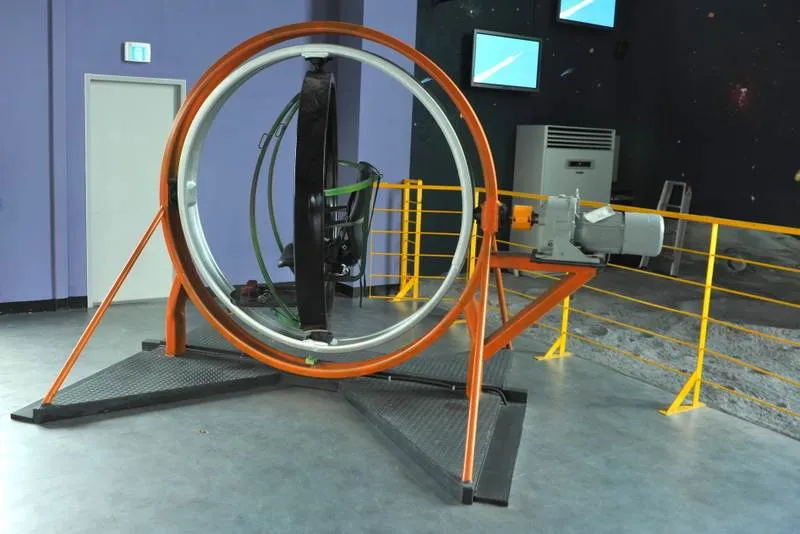In many ways, the Yecheon Space Center (예천천문우주과학공원) is a microcosm of many other Korean tourist destinations. They sound fancy, and it’s clear there was plenty of money available to make the thing come into existence. Arriving, however, becomes more than half of the battle — that is, trying to ensure one’s way to an out-of-the-way place in a still-sometimes-foreign country and getting back in a way to keep to your schedule. Even after arriving, the compelling reason to make your way here often ends up leaving you disappointed, and the success of the center seems to run parallel with the country’s ambitions of space.

Also called the Nailseong Observatory (나일성 천문관), the facility opened in November of 2004 as the first Korean facility about astronomy. That was the same year Vladimir Putin and Roh Moo-hyun signed an agreement to put a South Korean astronaut on board a Soyuz spacecraft. Over the next couple of years, the Korean government instituted a program to select an astronaut to sent to space; according to a Yonhap article, over 36,000 applications were received. Two astronauts were eventually chosen, and in April of 2008, Yi So-yeon spent 10 days on board the International Space Center conducting experiments. In 2009, the Yecheon-based center selected a sub-orbital vehicle for private space tours that may launch as early as 2014.
On a mildly related note, the Yechon Space Center serves as home for the curious “International Planetarium Movie Festival” — or so a poster claims.

The history of Korean space exploration goes back to the late 20th century, with the goal of putting a satellite in orbit. To that end, Korea partnered with Russia’s Khrunichev State Research and Production Space Center, presumably to take advantage of their decades of rocket-making expertise. The first satellite, a ‘microsatellite’ was launched in 1992, with other Korean satellites being launched around the world. One other consequence of the astronaut program: space kimchi. According to a New York Times article, three top government research institutes went to work on making a bacteria-free version of the fermented cabbage. Millions of dollars later, successful kimchi was created that could safely travel to space. Strange that none of that money went to maintain a site more likely to be seen by future astronauts.

Having sent a Korean to space, the initiative then turned to ensuring a way to way to deliver satellites to space. The first-stage rocket (designed by Russia) and the second-stage rocket (designed by Korea), however, has had more than its share of problems. The first launch on 25 August 2009 ended with a problem that made it impossible to deploy the satellite. The follow-up attempt, on 10 June 2010, exploded just over two minutes after launch. The third attempt was scheduled for 26 October 2012, but delayed because of a leak between the first stage rocket and the connection pad.
With that history in mind, the tourist destination hasn’t seen much in the way of traffic or tourists. The day we went, kids outnumbered the adults, who seemed less enthusiastic about space and more enthusiastic about this:

I just wish I still fit into those tubes…
Walking around the rest of the outdoor exhibits reveals a number of greats:

Newton with his apple, immortalized in better condition than Jupiter.
Head up to the top first to enjoy the expansive view:

Coming during the day means there are few stars to take in, but the countryside is nice.
It’s inside where things get a bit weirder:

Yep, that’s a alien carrying a Santa-like bag in a UFO. In the back is a world where aliens are emerging from… Florida?! Well, that explains it all…

For obvious reasons we weren’t allowed to use a camera while on the gyroscope. Rest assured this is the same exact device you’ve seen astronauts training on, and the 1–2 minute ride is more than enough to give your head a rush.

Just around the corner is the moonwalking simulator — a winch is raised to a person’s height, then the springs kick in. The kids pictured here seemed content with being bobbed up and down, but we jumped — you can get about 5 meters up. The only hitch in the process is the seat — designed like a bicycle seat but you can never really get comfortable on the back…

Feel some G’s here — the thing spins around and around, but your brain is tricked into thinking you’re going up thanks to a video and clever tilting.
Speaking of videos, the 4D movie, all about a dinosaur named Dinky, was actually a little disturbing. I’m unsure whether I’d let elementary-schoolers watch one dinosaur eat another dinosaur — and it stretches credibility to believe dinosaurs were ever altruistic. It’s entirely in Korean, and best for the under-10 crowd that still enjoy the Korean clone of the Power Rangers.

Compare your weight on Earth versus Mars.

There’s very little English around, and the staff ended up following or guiding us around — being some of the only people around means we gave them something to do. It’s fun, but a bit outdated; perhaps as Korea’s space ambitions rise so will the fate of this area.
Name: Yecheon Space Center (예천천문우주과학공원)
Address: Gyeongsangbuk-do Yecheon-gun Gam-cheon-myeon Deok-yul-ri 91
Korean address: 경상북도 예천군 감천면 덕율리 91
Directions: Get to Yecheon Intercity Bus Terminal — From Dong Seoul Terminal, buses leave at 6:40am, 7:40, 9:00, 10:40, 11:40, 1:40pm, 2:40, 3:40, 5:10, 6:40, and 8:30, and take a bus for Gamcheon (감천), Oncheon (온천), Beolbang (벌방), or Punggi (풍기). These don’t come very often — about every 1 1/2 hours — so consider getting a taxi for a 15 minute ride.
Hours: 10am-6pm — a night program exists from 7pm-10pm (reservations required)
Admission: 2,000 won gets you in, although you didn’t come all this way just to see a few panels about space in Korean. Pay 10,000 won to get the full package as described above.
Phone: 054–654–1710
Website: http://www.portsky.net/english/


